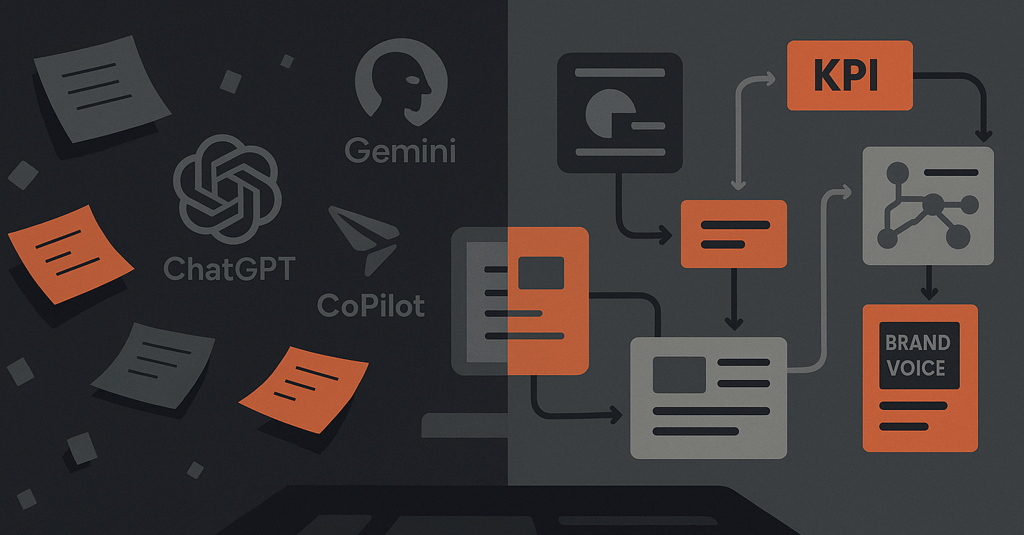Using AI Isn’t a Strategy. Integrating It Is.
Most teams are using AI in marketing. Few are using it well. Here’s how to move from tools to true strategy—and get results that scale.
5/12/20253 min read


You’re Using AI in Marketing—But Do You Actually Have a Strategy?
AI is everywhere in marketing right now. But that doesn’t mean you’re using it strategically.
At Vibe MKTG, we see the same issue across in-house teams, agencies and founders: The tools are there. The output is increasing. But there’s no real AI marketing strategy behind it. Using ChatGPT, Gemini or CoPilot isn’t a strategy. It’s just activity. And activity without alignment means wasted time, generic content, and missed opportunities.
Here are 10 signs your AI marketing setup is surface-level—and how to fix it.
1. You’ve got ChatGPT Pro—but no prompt library
AI can do a lot. But if you’re reinventing the prompt every time, you’re not scaling anything.
What to do instead: Create a branded prompt library. Build standardised, high-performing prompts for blogs, email subject lines, product pages and social posts. Treat prompts like internal templates, not experiments.
2. You’re automating content—but not optimising it
A key failure in most AI content strategies: more content, no performance lift. If you’re not iterating based on real data, you’re just publishing faster, not smarter.
Fix it: Use AI for testing, personalisation and reworking low-performing assets. Make optimisation—not output—your priority.
3. You don’t know what AI should actually do
Throwing AI at everything is not a strategy. Some tasks should be automated. Others should be AI-assisted. Some need to stay human.
Fix it: Audit your marketing workflows. Assign roles:
Automate repetitive work
Augment insight-led or data-heavy work
Keep creative, judgement-led decisions human
4. Brand voice is becoming generic
If your copy sounds like everyone else using AI, you’re not building a brand. You’re blending in.
Fix it: Train your AI tools using past brand content. Save tone-setting prompts and enforce human editing before publishing. AI in marketing should scale your voice—not flatten it.
5. Your team still writes everything from scratch
Blank-page syndrome is a productivity killer. AI can accelerate first drafts and ideation—freeing your team up to focus on value, not volume.
Fix it: Use AI to build outlines, suggest structure, or generate raw copy. Then refine and finalise with human judgement.
6. There’s no feedback loop
No matter how often you use AI, if you’re not learning from the results, you’re standing still.
Fix it: Track what’s working. Feed back winning formats and edits into your prompt system. AI should evolve with your brand.
7. You’re not measuring AI’s impact on performance
If you can’t tie your use of AI to real marketing outcomes, it’s not a strategy. It’s busywork.
Fix it: Set clear metrics for your AI marketing efforts:
Time saved per asset
Conversion rate changes
Cost per lead
Campaign turnaround time
8. Your AI tools are stuck in silos
Different teams use different tools, with no coordination or consistency. The result? Fragmented messaging and wasted effort.
Fix it: Create a shared AI playbook. Align tools, prompts and workflows across your teams. Strategy = system.
9. Leadership sees AI as a trend—not a capability
If your senior team sees AI as a toy for marketers or copywriters, your business is missing the bigger opportunity.
Fix it: Position AI as a cross-functional enabler: from faster insights to smarter decisions. Your AI marketing strategy should connect to business-wide goals—not just comms output.
10. You’re using AI to do more—not to do better
Faster content doesn’t mean better marketing. Strategy means knowing when to slow down, test, and learn.
Fix it: Use AI to support higher-quality decisions:
Smarter segmentation
More relevant messaging
Faster A/B testing
Better use of customer insight
The point isn’t more. It’s more effective.
AI is not your marketing strategy. But it should be built into it.
Brands that win with AI aren’t the ones chasing tools—they’re the ones building systems.
If you’re using AI in marketing but haven’t aligned it to your broader goals, messaging, and workflows, it’s time to rethink how you’re working.
Need help turning your AI activity into an actual strategy?
📩 Get in touch or connect on LinkedIn.
vibe MKTG Ltd is incorporated in England and Wales under company number 13728564.
vibe MKTG® is a registered trademark. All rights reserved.
Site designed by: AI Conductor + ChatGPT.